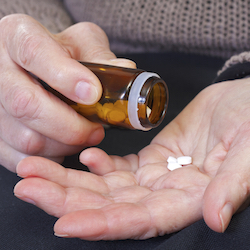By Michael Jurgelewicz, DC, DACBN, DCBCN / Osteoarthritis is the most common form of arthritis, also  known as the “wear and tear” arthritis. It occurs when the cartilage of the joints breaks down over time, and it can affect any joint in the body. Osteoarthritis is a major cause of functional disability as we age. When looking at all of the chronic diseases suffered by the elderly, osteoarthritis and osteoporosis are the most common.
known as the “wear and tear” arthritis. It occurs when the cartilage of the joints breaks down over time, and it can affect any joint in the body. Osteoarthritis is a major cause of functional disability as we age. When looking at all of the chronic diseases suffered by the elderly, osteoarthritis and osteoporosis are the most common.
Although there is a substantial amount of scientific and clinical research on osteoarthritis, there is no uniform agreement regarding the cause and pathogenesis of the condition. It is generally agreed that cause is multifactorial.
Associated risk factors for the development of osteoarthritis include:
- Age
- Gender
- Mechanical stress
- Joint trauma
- Genetic predisposition
- Ethnicity
- Obesity
- Dietary habits
The prevalence of co-morbid conditions makes treating elderly osteoarthritis patients different from treating other populations. Many of these elderly patients are on numerous medications which can have interactions or serious side effects. Therefore, the treatment or management of a variety of conditions in the elderly population can be a challenge.
Currently, there is no medical treatment that prevents or slows down the progression of osteoarthritis. The standard of care focuses primarily on alleviating symptoms with nonsteroidal anti-inflammatory drugs (NSAIDs). This initial frontline treatment may initially be helping the patients with their symptoms but, in the long run, it may be driving the pathological pathway even further.
 Individuals may have a temporary improvement in their range of motion and may experience reduced pain, yet in many cases the joints and discs continue to degenerate. This may be due to the fact that anti-inflammatory medications may actually impair the repair of connective tissue through some of the same mechanisms that the body uses to reduce inflammation.
Individuals may have a temporary improvement in their range of motion and may experience reduced pain, yet in many cases the joints and discs continue to degenerate. This may be due to the fact that anti-inflammatory medications may actually impair the repair of connective tissue through some of the same mechanisms that the body uses to reduce inflammation.
For many people who need anti-inflammatory therapy on an ongoing basis because of a chronic pain condition, they don’t really have a great conventional solution to turn to without some significant side effects. The chronic use of NSAID medications has been linked to increased intestinal permeability. In addition, a large majority of patients with serious GI complications due to NSAIDs do not even have preceding mild side effects. Often, their first symptom that they associate with the NSAID medication can be something as serious as a bleeding ulcer or perforation, and not typically some of the less alarming symptoms someone might experience, such as stomach discomfort.
Natural Alternatives to NSAIDs
The most common nutrients currently available that offer support for connective tissue are glucosamine, chondroitin, collagen hydrolysates, MSM, and hyaluronic acid. There are also two specific plant extracts, Scutellaria baicalensis and Acacia catechu, which are powerful flavonoids with anti-inflammatory properties. Researchers initially screened over 1,200 plant extracts for COX-1, COX-2, and 5-LOX activity. Among the 1,200, these were the only two demonstrating COX-1, COX-2, and 5-LOX activity without toxicity.*
These two botanical extracts have been formulated into a proprietary mixture called Flavocoxid, which is a specially formulated medical food containing the same “active” constituents and micronutrients that can be found in many fruits, nuts, vegetables, and teas.
Medical foods are an FDA-regulated category of products intended for the dietary management of a disease or condition that has distinct nutritional requirements. Unlike drugs, the ingredients in medical foods must be generally recognized as safe (GRAS). Typically, medical foods are not associated with negative side effects that are commonly seen with pharmaceuticals. For example, many NSAIDs are contraindicated for patients on anticoagulant medications, whereas human warfarin studies showed no interaction with Flavocoxid. Flavocoxid has been shown to be as effective as naproxen in managing knee osteoarthritis, and produced improvement in 87% of patients.
Are these natural alternatives as strong as taking something like ibuprofen? No they are not. They are much more subtle in their action, but this is not a bad thing. They have an action that spreads across multiple enzyme systems, which is often a better way to go because you get the effect you want without the potential downstream side effects such as edema, hypertension, ulceration, or renal dysfunction.
Instead of using an agent like an NSAID – which can be compared to a powerful big hammer that is being used on a very limited pathway or with a limited mechanism – choosing to use a nutrient such as Flavocoxid is more in line with using a smaller, more focused tool that can ultimately reach across a broader spectrum. The end result is a balanced inhibition of COX-1, COX-2, and 5-LOX pathways in order to help provide increased mobility and function.
Book Source: Jia Q. 2003. Generating and screening a natural product library for cyclooxygenase & lipoxygenase dual inhibitors. Studies in Natural Product Chemistry. 29:P643-718.
This blog was provided by Designs for Health, sponsor of Today’s Practitioner’s Osteoarthritis Resource Centre. For more information on click here.
Save





